
Jamaica is an island country situated in the Caribbean Sea. Spanning 10,990 square kilometres (4,240 sq mi) in area, it is the third-largest island of the Greater Antilles and the Caribbean. Jamaica lies about 145 kilometres (90 mi) south of Cuba, and 191 kilometres (119 mi) west of Hispaniola ; the British Overseas Territory of the Cayman Islands lies some 215 kilometres (134 mi) to the north-west.

The erebid moth Ascalapha odorata, commonly known as the black witch, is a large bat-shaped, dark-colored nocturnal moth, ranging from the southern United States to Brazil. It is the largest noctuoid in the continental United States. In the folklore of many Central American cultures, it is associated with death or misfortune.

The Dalceridae are a small family of zygaenoid moths with some 80 known species encompassing about one dozen genera mostly found in the Neotropical region with a few reaching the far south of the Nearctic region.
Evergestella is a genus of moths of the family Crambidae. It contains only one species, Evergestella evincalis, which is found in Florida, as well as on the Cayman Islands, Cuba, Puerto Rico and Jamaica.
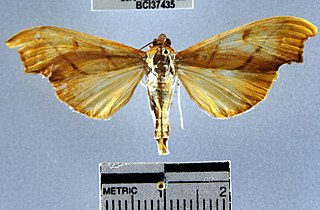
Sparagmia is a monotypic moth genus of the family Crambidae described by Achille Guenée in 1854. Its only species, Sparagmia gonoptera, described by Pierre André Latreille in 1828, is found in Central and South America and in the Antilles. Records include Argentina, Brazil, Panama, Costa Rica, Puerto Rico, Cuba and Jamaica.
Antiblemma rufinans, the live oak antiblemma, is a moth of the family Noctuidae. The species was first described by Achille Guenée in 1852. It is found in dry, sandy woodlands, barrens, and scrub forests of the southern Florida plain. It is also present in South America, Cuba and Jamaica.

Anthanassa frisia, the Cuban crescentspot, Cuban checkerspot or Cuban crescent, is a butterfly of the family Nymphalidae. Subspecies tulcis is known by the common names pale-banded crescent or Tulcis crescent; it is treated as a species by some authors. The nominate subspecies is found in the West Indies and southern Florida, with strays to northern Florida. Subspecies tulcis is found from Argentina north through Central America and Mexico to southern Texas, strays to west Texas and southern Arizona. Other subspecies are resident to South America.
Jocara majuscula is a species of snout moth in the genus Jocara. It was described by Gottlieb August Wilhelm Herrich-Schäffer in 1871, and it is found in California, Florida, Central America, Cuba, Puerto Rico and Jamaica.
Eublemma recta, the straight-lined seed moth, is a moth of the family Erebidae. The species was first described by Achille Guenée in 1852. It is found in the United States from South Carolina to Florida and west to Texas. It is also found south to Argentina, on Cuba, Jamaica and Puerto Rico.

Elaphria subobliqua is a moth of the family Noctuidae. It is found from Mexico to Paraguay and on Jamaica, Cuba and Puerto Rico. It was first reported from Texas in 2004.

Dypterygia punctirena is a moth of the family Noctuidae. It is found on Hispaniola, Jamaica and Puerto Rico and has also been reported from Florida.
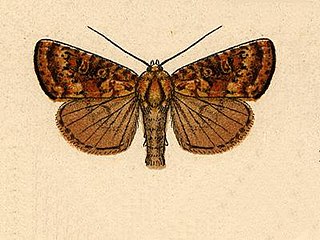
Perigea xanthioides, the red groundling moth or pied groundling moth, is a moth of the family Noctuidae. The species was first described by Achille Guenée in 1852. It is found from Canada to Brazil and on Jamaica. The wingspan is about 29 mm. The larvae feed on Vernonia and Eutrochium species.
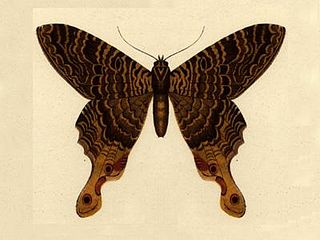
Mania aegisthus is a moth of the family Sematuridae. It is found in Jamaica, Haiti and Surinam.

Ptichodis herbarum, the common ptichodis moth, is a moth in the family Erebidae. It is found in the United States. It has also been recorded from Jamaica.

Eriopyga crista is a moth of the family Noctuidae found from the southern United States through Central America to South America and on the Antilles.

Ametris nitocris, the seagrape spanworm moth, is a moth of the family Geometridae. The species was first described by Pieter Cramer in 1780. It is found from the southern United States through Central America to South America. It is also found on the Antilles.
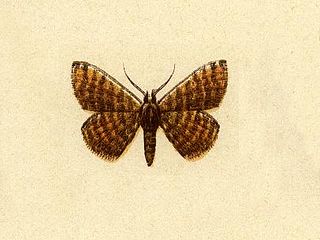
Leptostales phorcaria is a moth of the family Geometridae. It is found on Puerto Rico, Hispaniola, Jamaica, the Bahamas and St. Vincent.
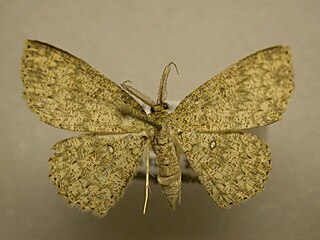
Cyclophora urcearia is a moth of the family Geometridae. It is found from Mexico to Paraguay and on Jamaica and in Trinidad.
Psychonoctua personalis is a moth in the family Cossidae. It was described by Augustus Radcliffe Grote in 1865. It is found on Cuba, Jamaica, Hispaniola and Puerto Rico.
Glaphyria bilinealis is a moth in the family Crambidae. It is found in Cuba, Jamaica, Puerto Rico and on the Virgin Islands.













